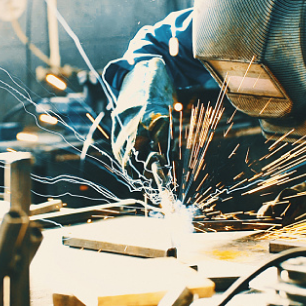Jump to:
Quality Planning for Steel Construction Inspection
A site-specific quality plan (SSQP) is critical to the project’s quality. It contains quality information such as seismic criteria, architecturally exposed structural steel (AESS) criteria, inspection criteria, and unique bolting, including removal of backing and run-off tabs, and tolerance criteria. It is critically important for the team to understand these issues prior to bidding or starting the work. This article provides an overview of the contract documents, codes and standards, certifications, inspection activities, and reporting for developing SSQPs. A SSQP can convey this information to minimize repairs and improve margins.
Elements of an Inspector Quality Plan
A typical quality control and quality assurance (QC/QA) inspection plan should contain the following components:
- Site safety information (getting everyone home safely);
- Field contacts (general contractor, erector, site superintendent, and detail foreman);
- Inspection timing (full-time vs. occasional);
- Quality requirements for bolting, welding, decking, and tolerances;
- Access considerations for inspections;
- Nondestructive testing (NDT) requirements; and
- Reporting and distribution procedures.
- Some of the essential terms the inspector must be familiar with when establishing a quality plan are as follows:
- Contract documents: These documents define the responsibilities of the parties involved in bidding, fabricating, and erecting structural steel. They normally include design documents, specifications, and the contract.
- EOR: Engineer of record.
- Fabricator: The entity responsible for detailing and fabricating the structural steel (except in American Institute of Steel Construction [AISC] 303, Code of Standard Practice for Steel Buildings and Bridges, Section 4.5).
- Erector: The entity responsible for the erection of the structural steel.
- Specifications: The portion of the contract documents that contains the written requirements for materials, standards, and workmanship.
- Quality Control: Inspection performed by the fabricator or erector.
- Quality Assurance: Inspection by someone other than the fabricator or erector (QA verifies QC is being performed adequately).
- AWS QC1, Specification for AWS Certification of Welding Inspectors, and B5.1, Specification for the Qualification of Welding Inspectors.
- Observe (O): The inspector shall observe these items on a random basis. Operations need not be delayed pending these inspections.
- Perform (P): These tasks shall be performed for each bolted or welded joint or member.
Contract Document Review
Contract documents are how you get the information onto a site-specific quality plan. You must review the contract documents for quality-related items as part of an inspector’s duties and the AISC certification, and if an AISC certified fabricator or erector, the AISC 207, Standard for Certification Programs, requires this review. When reviewing the contract documents, ensure the code dates and references are correct and the plans are reasonably developed. It is common to see one code edition referenced on the design drawing, and a different one for the project specifications. Be vigilant of these discrepancies. Additionally, ensure the inspection criteria is achievable.
Some other common issues in contract documents include vague filler metal specifications and inspection requirements, such as “NDT at the discretion of a third-party inspector.” Companies can’t bid using these ambiguous requirements because they are not enforceable. Consider adding a requirement that filler metals comply with the latest edition of AWS D1.1, Structural Welding Code — Steel, and consider adding specific NDT requirements, not “at the third-party’s discretion.”
Code Standards Hierarchy
Contract documents specify legally binding codes and standards for the project, and the codes and specifications contain references that are legally binding. The hierarchy of codes and standards are as follows:
- International Building Code (IBC) is typically referenced in contracts, making it legally binding.
- IBC references AISC 360, Specification for Structural Steel Buildings, and AISC 341, Seismic Provisions for Structural Steel Buildings.
- AWS D1.1 is referenced through AISC 360; D1.8, Structural Welding Code — Seismic Supplement is referenced through AISC 341.
- Some of the key code sections are as follows:
- AISC 303 includes AESS tolerances and commercial issues.
- AISC 360:
- Chapter A, General Provisions, which includes the EOR requirements.
- Chapter M, Fabrication and Erection
- Chapter N, Quality Control and Quality Assurance
- AISC 341:
- Chapter A, General Requirements
- Chapter I, Fabrication and Erection
- Chapter J, Quality Control and Quality Assurance
- Research Council on Structural Connections, Specification for Structural Joints Using High-Strength Bolts:
- Section 1 – EOR requirements
- Section 2 – Building Components
- Section 3 – Bolted Parts
- Section 4 – Joint Type
- Section 5 – Limit States in Bolted Joints
- Section 6 – Use of Washers
- Section 7 – Preinstallation Verification
- Section 8 – Installation
- Section 9 – Inspection
- Section 10 – Arbitration
AISC 360 Chapter N
AISC 360-22, Chapter N, Quality Control and Quality Assurance, forms the foundation in developing a quality plan for steel construction inspection. Chapter N is organized as follows:
- N1. General Provisions — EOR
- N2. Fabricator and Erector Quality Control Programs (QC plans and procedures for welding, cutting, and tolerances, for example)
- N3. Fabricator and Erector Documents — Submittal and available documents: Submit shop and erection drawings; all else must be available.
- N4. Inspection and Nondestructive Testing Personnel — This section addresses qualification of inspectors.
- N5. Minimum Requirements for Inspection of Structural Steel Buildings — This section includes the following:
- Inspection task tables for bolting and welding
- Coordinated Inspection: QC/QA may be performed by the same party.
- Mandatory NDT for complete joint penetration (CJP) welds in Risk II, III, and IV Category tension loaded welds
- UT rejection rate, reduction of UT rate, and increase in UT rate
- Inspection of galvanizing
- Other inspection tasks: the quality control inspector (QCI) verifies compliance to drawings, and the quality assurance inspector must be onsite during installation of anchor rods and other embedments.
- N6. Approved Fabricators and Erectors — QA may be waived with approval of the authority having jurisdiction (AHJ). QC may perform NDT; QA to review reports.
- N7. Nonconforming Material and Workmanship — Timely inspection and reporting.
- N8. Minimum Requirements for Shop- or Field-Applied Coatings — This section provides requirements for coating procedures and minimum inspection requirements.
AWS D1 Codes
The primary AWS structural welding codes inspectors use in steel construction are D1.1 and D1.8, which work together like AISC 360 and 341. Other AWS codes used are D1.3, Sheet Steel Welding; D1.4, Structural Welding Code — Steel Reinforcing Bars; D1.5, Bridge Welding; and D1.6, Stainless Steel Welding.
The contents of AWS D1.1/D1.1M:2025 are as follows:
- Clause 1: General Requirements
- Clause 2: Normative References
- Clause 3: Terms and Definitions
- Clause 4: Design of Welded Connections
- Clause 5: Prequalification of WPSs
- Clause 6: Qualification
- Clause 7: Fabrication
- Clause 8: Inspection
- Clause 9: Stud Welding
- Clause 10: Tubular Structures
- Clause 11: Strength and Repair of Existing Structures
Inspector Certification Requirements
Certification consists of many accreditations and endorsements, but for the scope of this article, we will focus on AWS and AISC certifications.
AWS Welding Inspector Certifications
The acceptable qualification criteria are as follows:
- AWS Certified Welding Inspector (CWI) or Senior Certified Welding Inspector (SCWI) in conformance with the requirements of AWS QC1.
- A Level 2 or Level 3 Welding Inspector in conformance with the requirements of the Canadian Standards Association Standard W178.2, Certification of Welding Inspectors.
- A Welding Inspector (WI) or Senior Welding Inspector (SWI) in conformance with the requirements of AWS B5.1, Specification for the Qualification of Welding Inspectors.
- An American Society of Nondestructive Testing (ASNT) SNT–TC–1A Visual Testing (VT) Level II inspector in conformance with the requirements of ASNT Recommended Practice No. SNT-TC–1A, Personnel Qualification and Certification in Nondestructive Testing, or ANSI/ASNT CP-189, ASNT Standard for Qualification and Certification of Nondestructive Personnel.
- An individual who, by training or experience, is competent to perform the work in metal fabrication, inspection, and testing. This is one of the most critical and abused requirements. This abuse typically consists of nominal training without documentation. The training should be relevant to the QCI’s task and capability, and this training should have assessment and be documented.
The purpose of this subclause is to provide a method for trainees and personnel who work to very specific tasks, for example, reviewing metal deck or only reviewing fillet welds for a product. Training should consist of a written training outline, requirements for mentoring, and an assessment test.
AISC 360 Chapter N and 341 Chapter J
The acceptable qualification criteria are as follows:
1. N4.1 Quality Control Inspector Qualifications. QC welding inspection personnel shall be qualified to the satisfaction of the fabricators or erector’s QC program, as applicable, and in accordance with either of the following: (a), Associate Welding Inspectors (AWI) or higher as defined in AWS B5.1, or (b), qualified under the provisions of AWS D1.1/D1.1M:2025, Clause 8.1.4, Qualification of Inspection Personnel.
QC bolting inspection personnel shall be qualified based on documented training and experience in structural bolting inspection.
2. N4.2 Quality Assurance Inspectors. QA welding inspectors shall be qualified to the satisfaction of the QA agency’s written practice, and in accordance with either of the following: (a) WI or SWI, as defined in AWS B5.1:2025, except AWIs are permitted to be used under the direct supervision of WIs, who are on the premises and available when weld inspection is being conducted, or (b), qualified under the provisions of AWS D1.1/D1.1M:2025. Clause 8.1.4.
QA bolting inspection personnel must be qualified based on documented training and experience in structural bolting inspection.
Pre-job Meetings
Pre-job meetings with the parties responsible for design, construction, fabrication, erection, and inspection are critical for project success. Standalone quality meetings are most effective, as they present a key opportunity to align on inspection criteria and help establish relationships with ironworkers and supervisors.
A pre-job meeting facilitates reviewing and discussing contract documents, codes and standards, certifications for QC/QA, inspection (including access, timing, and field contacts), and reporting requirements. Additionally, it’s a good opportunity to understand the perspective of the ironworkers, the superintendent, and the detail foreman.
Timeliness of Inspections
Timely inspections are essential to the project’s success and the safety of inspection crews. Avoid inspections after fabrication has moved out of the fitting and welding area or after an erector has demobilized from an area. It is safer and less costly to inspect and repair, if necessary, while access and crews are at the connection.
AISC 303-22, Clause 8.5, Independent Inspection, provides some helpful guidelines on the timeliness of inspections, as follows:
- The fabricator and the erector must provide access and a minimum of 24 hours’ notification.
- The inspector must thoroughly inspect shop work in the fabricator’s shop, if possible.
- Field inspection must be promptly completed without delaying the progress or correction of the work.
- Inspections must be timely, in sequence, and performed in such a manner as will not disrupt fabrication or erection operations.
- Rejection of material or workmanship that does not conform to the contract documents must be permitted at any time during the work’s progress. However, this provision must not relieve the owner or the inspector of the obligation for timely, in-sequence inspections.
Inspection of Bolted Connections
QC and QA bolting inspection personnel must be qualified based on documented training and experience in structural bolting inspection. The International Code Council (ICC) S1 Structural Steel and Bolting certification is an option. Table N5.6-1 from AISC 360-22, Chapter N, Inspection Tasks Prior to Bolting, offers a checklist on QC/QA duties, as follows:
- Manufacturer’s certifications available for fastener materials
- Fasteners marked in accordance with ASTM requirements
- Correct fasteners selected for the joint detail (grade, type, bolt length if threads are to be excluded from shear plane)
- Correct bolting procedure selected for joint detail
- Connecting elements, including the appropriate faying surface condition and hole preparation, if specified, meet applicable requirements.
- Preinstallation verification testing by installation personnel, observed and documented for fastener assemblies and methods used
- Protected storage provided for bolts, nuts, washers, and other fastener components.
Inspection of Welded Connections
The two primary codes used for structural steel welding inspection are AWS D1.1, which describes how to inspect and the acceptance criteria for welded connections, and AISC 360 Chapter N, which provides the required frequency of inspections.
Table N5.4-1 from AISC 360-22, Chapter N, Inspection Tasks Prior to Welding, offers a checklist on QC/QA duties as follows:
- Welder qualification records and continuity
- WPS available
- Manufacturer certifications for welding consumables available
- Material identification (type/grade)
- Welder identification system
- Fit-up of groove welds (including joint geometry)
- Fit-up of CJP groove welds of HSS T-, Y-, and K-connections without backing (including joint geometry)
- Configuration and finish of access holes
- Fit-up of fillet welds
- Check welding equipment
Shop and Field Inspection Drawings
QC/QA must have drawings readily available, as specified in AISC 360-22, Chapter N, Clause 5.1. These drawings must also meet any specific requirements, such as removal of backing, use of a specific filler metal, requirements for bolt tension, and any unique inspection, such as hold points, waiting for inspection, and magnetic particle testing of root pass for partial joint penetration welds.
Metal Deck and Studs Inspection
The Steel Deck Institute develops standards for the design and installation of steel decks commonly used in building floors and roofs. QC requires an AWS Certified Associate Welding Inspector (CAWI) or training and experience, and QA requires a CWI or higher (or CAWI with CWI or higher on the premises). QA also permits training and experience. Inspectors for mechanical fasteners must be qualified based on training and experience for a similar type of work.
Reporting
Some of the requirements that architectural and engineering services should expect from an inspector’s report are as follows:
- Date, time, weather, inspector, area, or members reviewed
- The code worked to the level of inspector certification
- AISC 360-22, Chapter N, Clause N4, Inspection and Nondestructive Testing Personnel
- Findings for the inspection tasks noted in AISC 360-22, Chapter N, Clause N5, Tables N5.4, N5.6, and N5.7.
- A punch list, or work-off list, for any defects noted that were not corrected at the time of visit (Clause N7).
When the welders or ironworkers come in at the end of the day and see the inspectors’ report, they would like to see it summarized. A punch list makes things a lot easier for the team.
UT Reporting
Any rejected weld by UT must be identified by marking directly over the flaw for its length and depth (see D1.1/D1.1M:2025, Clause 8.25.9, Indentification of Rejected Area). UT reports must meet D1.1/D1.1M:2025, Clause 8.26, Preparation and Disposition of Reports, which requires clearly identified areas of inspection, acceptance of the weld, and information on the rejection of a weld.
Report Distribution
Copies of the report must be provided to the fabricator and erector, per AISC 303. The contract documents should clearly state that all inspection reports are to be provided to the fabricator and erector on a timely basis so as not to delay operations, per AISC 360-22, Clause N7.
Conclusion
The relationship between inspectors and construction teams is vital. Effective quality planning relies on understanding code requirements, establishing clear inspection criteria, ensuring proper qualifications, planning for access, and maintaining timely communication between all parties involved in steel construction projects.
A good quality plan ensures that you and your team have reviewed the contract drawings, have the correct codes referenced, have the required personnel onsite, understand the inspection criteria, including NDT, have the access and timing with fabricator and erector input, and know the reporting requirements, including a punch list.
MIKE GASE (mgase@midweststeel.com) is the corporate quality director for Midwest Steel, Detroit, Mich. He is an AWS SCWI, ASNT Level III, chair of the AWS D1.4, Structural Welding Code — Steel Reinforcing Bars, member of the AWS D1 and D1Q committees, chair of the D1.1 fabrication and inspection committees, and a Welding Handbook committee member.


